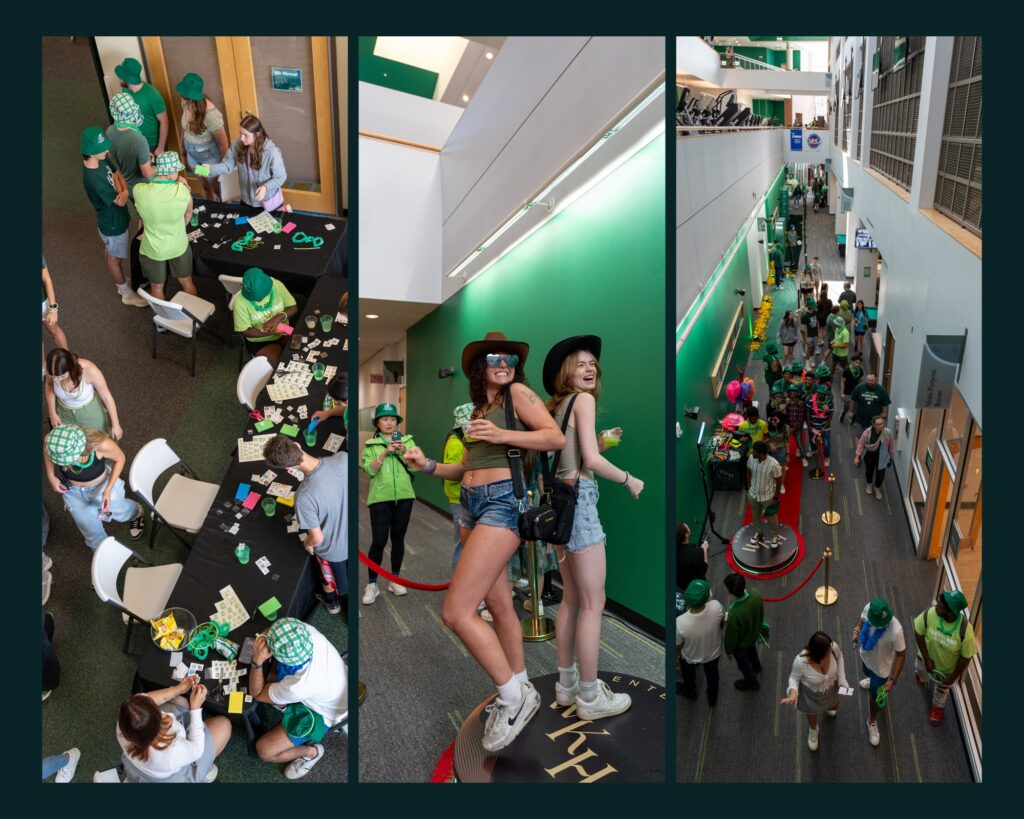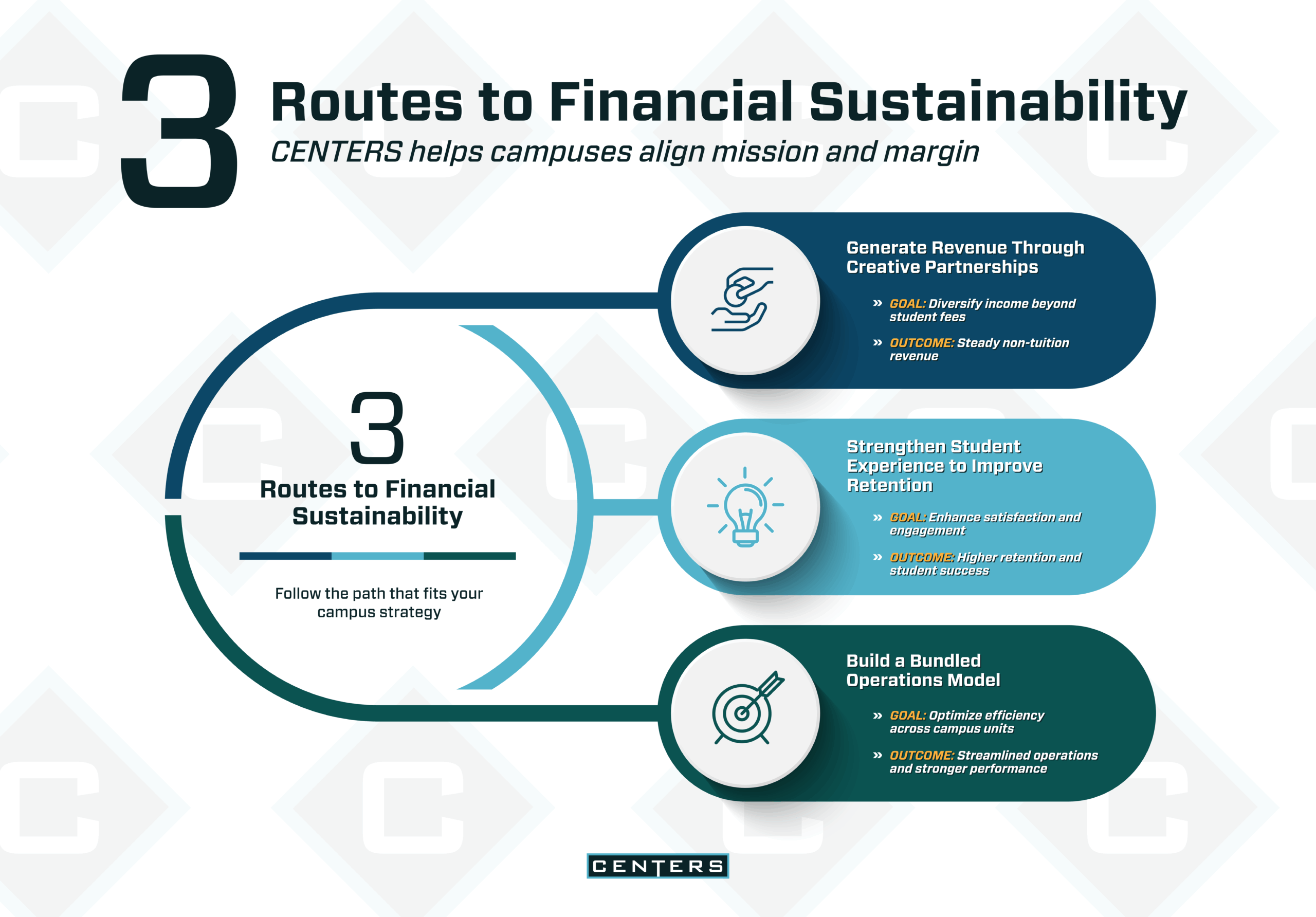How strategic partnerships help colleges balance budgets, enhance the student experience, and prepare for the demographic cliff
As the higher education “demographic cliff” approaches, the traditional playbook of focusing solely on enrollment growth may no longer be enough. For decades, colleges have emphasized enrollment and access, often prioritizing the number of students admitted. Today, long-term financial sustainability depends just as much on retaining those students through graduation.
Retention is now as critical as recruitment. It’s far more cost-effective to retain a current student than to invest resources to attract new ones. The next decade will challenge institutions to rethink how they support both student success and financial stability. Demographic changes, shrinking state budgets, and rising student expectations are forcing campuses to innovate to maintain both student success and financial sustainability.
According to Inside Higher Ed (2024), the number of 18-year-old high school graduates will peak in 2025 at around 3.9 million, followed by a 15-year decline. By 2041, the number of traditional-age incoming college students will be down 13 percent. The shift won’t be evenly distributed. Projections show a handful of states that may see significant increases, including Florida, Idaho, North Dakota, North Carolina, and Tennessee, while most others will experience steady declines.

Why Outsourcing Student Services Matters More Than Ever
In this environment, institutions must focus on their core mission—education—while finding new ways to sustain and enhance student services. One proven approach is outsourcing operational areas that are essential to the student experience but not the institution’s primary area of expertise.
Outsourcing allows colleges and universities to ensure high-quality student support services while simultaneously committing more resources to teaching, research, and academic success—the foundation of higher education institutions. It is not about relinquishing control. It is about trusting a proven partner to manage what is not your core strength so you can focus on what is.
CENTERS, a management company specializing in operating campus life facilities, offers an example of this model in action. CENTERS manages recreation and wellness centers, arenas, student centers, sports complexes, event and conference services, performing arts centers, and more. Through economies of scale and specialized expertise, CENTERS helps institutions lower operating costs, increase revenue potential, and improve the student experience.
When a partner like CENTERS manages campus assets, institutions benefit from full back-office support. With human resources, accounting, and corporate operational systems covered, on-site professional staff can focus on students, programs, and outcomes. This structure allows institutions to operate efficiently and strategically, supported by robust corporate resources.
The hard truth is that operating as a pure cost center is no longer sustainable for most institutions. While student retention is the primary goal, many campuses are discovering ways to offset expenses with external rentals, corporate partnerships, and community memberships. It is often possible to subsidize student programs through creative external usage and partnerships.
The most successful models strike a balance between mission and financial sustainability. A company such as CENTERS has a long history of balancing revenue obligations with the delivery of student programs, services, and engagement. This combination is becoming increasingly critical as higher education institutions compete to recruit and retain a shrinking student population.
Case Studies: How Outsourced Management Boosts Student Retention and Revenue
A strong example of how an institution is adapting to enrollment declines can be seen at Cleveland State University (CSU). Last year, the university faced a $40 million budget deficit, due in part to significant enrollment declines. In August, the university offered buyouts to 50 faculty and staff members and laid off 14 more.
In 2005, CSU selected CENTERS to manage its campus recreation department. After several successful years managing the Rec, CSU recognized the value of an outsourced management partner and contracted CENTERS to also manage its Student Center (2022) and Conference and Event Services (2024). By outsourcing multiple units under one management structure, CSU benefits from shared resources, consistent service standards, and unified strategic planning. CSU also reaps the benefits of a partner combining corporate and on-site staff to manage multiple assets across campus.
CENTERS refers to this as its “bundled management model,” which integrates multiple auxiliary units under a single management umbrella. This approach reduces redundancy, optimizes staffing, and strengthens alignment between student experience and financial performance.
Read the Benefits of Bundling Case Study
In the Chicagoland area, DePaul University and Moraine Valley Community College—two very different institutions—share the commonality of outsourcing their recreation and fitness services. Each offers robust facilities, services, and programs to students through CENTERS management and generates significant external revenue. It is a win-win model for both institutions, providing cutting-edge student programs while generating meaningful revenue that offsets expenses and reduces reliance on student fees.
Actionable Insights: Choosing the Right Path for Financial Sustainability
Every institution is facing similar pressures but starting from different realities. Whether your primary challenge is declining student fees, stagnant enrollment, or rising costs, your best route forward depends on your operating paradigm.

Route 1: Generate Revenue Through Creative Partnerships
For campuses where student fee revenue is declining, sustainability depends on diversification.
Goal: Build a steady stream of non-tuition revenue that supports student programs and operations.
- Expand facility access through alumni, community, and employer memberships.
- Activate underutilized spaces for camps, certifications, esports, and rentals.
- Partner with external organizations for joint programming, sponsorships, or wellness initiatives.
Route 2: Strengthen Student Experience to Improve Retention
For mission-driven institutions, retention is the strongest form of revenue protection.
Goal: Improve satisfaction, engagement, and persistence—the metrics that stabilize enrollment and drive financial sustainability.
- Develop inclusive, purpose-driven programs that connect wellness to belonging, career readiness, and student success.
- Integrate student employment and leadership pathways within campus operations.
- Collaborate across departments (housing, dining, academic advising) to create holistic support systems.
Route 3: Build a Bundled Operations Model
For campuses managing multiple auxiliary units such as recreation, unions, events, and housing, bundling management under one operator drives efficiency and consistency.
Goal: Maximize value by combining campus life operations under one strategically coordinated management model.
- Share staff, systems, and marketing across units to reduce overhead.
- Centralize planning and performance metrics for unified reporting and accountability.
- Align goals across departments to create a seamless student and guest experience.
 Looking Ahead: Balancing Mission and Financial Sustainability
Looking Ahead: Balancing Mission and Financial Sustainability
Student success and financial sustainability are no longer competing priorities—they are parallel paths to long-term institutional health. Outsourcing non-core services enables institutions to achieve both: strengthen the student experience while protecting the bottom line.
At CENTERS, we partner with higher education institutions to design and operate sustainable campus life programs that balance mission and margin. Whether your institution seeks new revenue streams, greater operational efficiency, or a stronger student experience, the path forward begins with rethinking how your campus centers serve both your community and your financial future.
About the Author
 Mike Schneider is the Assistant Vice President of Operations at CENTERS, where he supports site leadership, business development, and facility start-ups. He played a key role in launching operations at The Sonnentag, a multi-use sports and events venue at the University of Wisconsin–Eau Claire. With a background in recreation and venue management at both two- and four-year institutions, Mike brings deep experience in optimizing campus assets for student and community impact. He began his career in campus recreation in 2003, previously served as director at two CENTERS-managed sites, and currently teaches Sport and Recreation Facility Management as an adjunct instructor.
Mike Schneider is the Assistant Vice President of Operations at CENTERS, where he supports site leadership, business development, and facility start-ups. He played a key role in launching operations at The Sonnentag, a multi-use sports and events venue at the University of Wisconsin–Eau Claire. With a background in recreation and venue management at both two- and four-year institutions, Mike brings deep experience in optimizing campus assets for student and community impact. He began his career in campus recreation in 2003, previously served as director at two CENTERS-managed sites, and currently teaches Sport and Recreation Facility Management as an adjunct instructor.
Sources
Inside Higher Ed. (2024, December 11). College-age demographics begin a steady projected decline. Inside Higher Ed. https://www.insidehighered.com/news/admissions/traditional-age/2024/12/11/college-age-demographics-begin-steady-projected-decline
